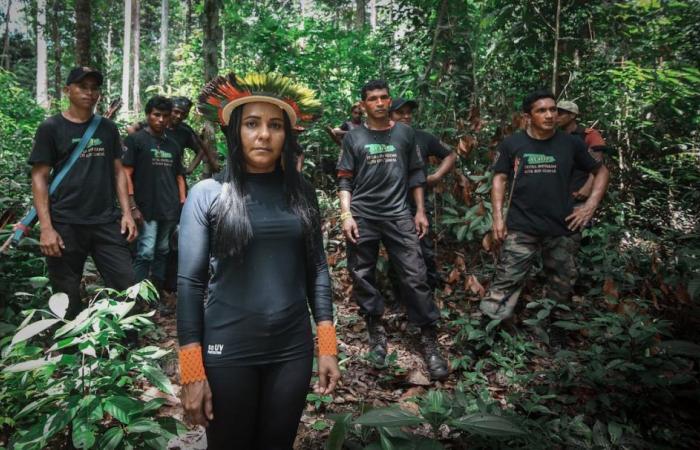EL PAÍS offers the América Futura section openly for its daily and global information contribution on sustainable development. If you want to support our journalism, subscribe here.
“My boot is no longer useful,” says an illegal logger named Valdir in the opening scene of We are Guardians, a documentary about the actions of indigenous people to save the Amazon rainforest. At 57 years old, Valdir has spent more than half of his life felling trees on protected lands, a trade that he learned from his parents. “We know that we work illegally,” he says. “If I stop working, I will die of hunger. My family and I, not just me.”
We are Guardians, available on Netflix Latin America, is not intended to arouse sympathy for the criminals involved in deforestation. On the contrary, the directors — Brazilian indigenous journalist Edivan Guajajara and American documentary filmmakers Rob Grobman and Chelsea Greene — are undaunted environmentalists, familiar with the language of activism. “We want legislators to see this film,” Grobman assures América Futura. The legislative staff of several members of the US Congress, including that of Bernie Sanders, senator from Vermont, have already seen the documentary. It was also seen by hundreds of attendees at last year’s United Nations Climate Change Conference in Dubai.
The three directors recognize that their commitment to social and environmental justice in the Amazon borders on the propagandistic. In post-production, the filmmakers deleted an entire scene because test audiences found one of the “invaders” too likable. Next to Valdir, a chain-smoking, foul-mouthed man, “this guy looked like Jesus,” Greene says. “Everyone who saw the clips “They felt bad when the forest guardians expelled him.” The man in question had occupied indigenous lands for a decade, cutting down trees for firewood, cultivating a garden and illegally using the resources of the Amazon.
During four years of filming, Greene, Grobman and Guajajara accompanied the self-proclaimed guardians of the forest on eight of their rounds in Araribóia, an indigenous territory in the heart of the Amazon. Throughout the film, the guardians try to stop the land invaders: drug traffickers, loggers, farmers, collectors, miners and illegal ranchers. But they usually stop petty thieves, some of whom have lived in the area for decades and whom the guards know by their first name.
On one of their rounds, the group spots two disheveled men in a canoe with a small amount of açaí illegally collected. “I think it’s Betinho and his brother,” one of the guards whispers. “They are gunmen.”
—Who authorized them to collect açaí?, asks another guardian.
Betinho’s brother, Henrique, begins to answer timidly: “We work here because we need to buy coffee, sugar…”
—You know it’s not allowed, right?
— Yes, sir, but our needs are great.
Another guardian intervenes: “You have no right to hunt, fish or plant here, do you understand?”
“This is their land, the indigenous territory,” Betinho concedes, his head bowed in respect. He lets a moment pass. “We want the açaí. I beg you”.
After consulting among themselves, the guardians allow the men to keep the açaí harvested for the first and last time. As he begins to paddle down the river, Henrique shouts: “They must go after the farmers, not the poor villagers!”
Some of the guardians laugh lightly, aware that lowly invaders like Henrique and Betinho are not the real enemy. But not all encounters are resolved so diplomatically. Since 2019, at least seven wardens have been killed on duty.
The reality is that, while guardians pursue opportunists like Valdir and Henrique, the forces driving deforestation continue to operate. “The biggest buyers are in the United States and China,” says Valdir, standing next to a downed tree. “Everything is packaged neatly and beautifully, with ‘legal’ labels, and leaves the country legally,” he laments.
Valdir barely makes enough to survive, but others will profit considerably from his work. “There are sawmills that illegally cut wood,” a conservationist tells the directors. “There are exporters who trade stolen wood.” Valdir puts it more vividly: “It is a system, a chain, and the chain is strong.” Guajajara, who grew up in Araribóia, also has mixed feelings towards petty criminals like Valdir. “They’re just trying to survive,” he says. “The most destructive are the large mining companies and the exporters of illegally logged timber.”
The directors tried for months to interview companies that supply the demand that leads to deforestation, such as JBS, a major Brazilian livestock buyer, and the American agribusiness giant Cargill. “We contacted their sustainability representatives,” Greene said. “We contacted politicians in Brazil who we know are working with them.” Some publicists spoke with the filmmakers confidentially, others blocked them, leaving a void in a documentary that, however, has been exhaustively researched.
Former Brazilian president Jair Bolsonaro appears as a villain in the story. During his sole term in office, from 2019 to 2022, he promoted commercial interests in the Amazon rainforest, cut budgets for environmental agencies, and reduced protections for indigenous groups. “Encouraged by the president, livestock and soy farms have been cut deeper and deeper into the Amazon,” a news anchor is heard saying in the documentary. “Illegal invasions of indigenous lands have tripled since Bolsonaro became president.”
And besides unscrupulous corporations or reactionary politicians, there is the biggest threat of all: global warming. In 2023, the Amazon rainforest recorded its worst drought to date. “It used to rain a lot,” says Marçal, one of the guardians, in the film. “But now the weather is not good.”
We are Guardians does not include many interviews of academics. The only expert listed is Luciana Gatti, a Brazilian climate scientist who has collected air samples in the region for almost a decade. Her findings are not encouraging. Long considered the largest carbon sink on the planet, the Amazon now has areas that emit more CO2 than they absorb. “The forest is dying faster than it is growing,” says Gatti. “If we do not restore the forests in the most devastated areas, the Amazon will exceed the point of no return.”
A study published in the scientific journal Nature Earlier this year, with two dozen co-authors from various disciplines, he reached the same conclusion. “There is a consensus that the Amazon is being depleted and pushed towards a possible tipping point,” Bernardo Flores, the lead author of the article, tells América Futura. Over the past fifty years, the Amazon has lost almost a fifth of its forest cover due to deforestation, which is the second largest source of greenhouse gas emissions, after the burning of fossil fuels.
Climate change models suggest that if the Amazon loses another 10% of forest cover, it would likely reach a tipping point, triggering a series of irreversible climate effects. Within a few decades, large tracts of rainforest could become depleted savannahs and shrublands, releasing billions of tons of carbon into the atmosphere. “If the world does not do what is necessary to control global warming,” Flores said, “perhaps it is useless to do anything at the local level.” In other words, without radical changes in public policy, an ecological spiral is imminent, and no amount of guardians will be enough to counteract the effects of climate change.
Indigenous groups have collective title to about a third of the Amazon basin, and deforestation rates are significantly lower in areas under their control. However, considering the increasing stressors in the Amazon, the effectiveness and equity of the indigenous guard model may be questioned. Those who do this unpaid work are few, poorly equipped, and burdened with the impossible task of monitoring more than 1,500 square miles of territory. “We will die, if necessary, for what remains of this jungle,” she says in the documentary Puyr Tembé, which she has been a guardian of since she was 12 years old. According to her, some members of her family have been killed by invaders.
Greene calls the gatekeepers a “temporary solution.” To stop the trade in the products of deforestation, he says, “we have to recognize the value of keeping the Amazon standing rather than logged.” His hope is that people will see the film and join his fight. “We want the public to disengage [de estos productos] and denounce the companies involved in deforestation.” Since the premiere, the filmmakers have raised more than $400,000 for patrolling and reforestation initiatives in Brazil’s indigenous territories. Marçal, one of the guardians, used his quota to buy a motorcycle, “to facilitate faster transportation to the invasion areas,” according to an impact report from the production team.
But stopping illicit deforestation in the Amazon will require more than the bravery of groups like the guardians or the goodwill of various benefactors. “Indigenous guardianship has given hope to our people,” says Guajajara, “but I don’t know if it is an adequate model.” Ultimately, he said, “there must be a robust system that allows the production chain to be traced, and severe sanctions for the large companies that carry out this destruction.”
President Luiz Inácio Lula da Silva appears briefly in the film at a press conference with Guardian Puyr Tembé, whom he appoints as first secretary of the Indigenous Peoples of the State of Pará. Among his government’s first initiatives was the creation of a special forces unit under the Ministry of Environment and Climate Change to help patrol the Brazilian Amazon. Federal agents are better armed than indigenous guardians, but are still understaffed and under-resourced.
One of the most moving scenes in the documentary shows Marçal at home with his family. “We are taking care of the jungle, but I worry about you,” his wife tells him. “If something happened to you, what would happen to us?” “No one else assumes leadership,” Marçal responds without hesitation. “That’s why I have to do this job.”
Even though he’s seen it dozens of times, Grobman is still moved by it. He finds Marçal’s bravery heartbreaking and beautiful at the same time. “The stewardship model won’t necessarily save the rainforest, but it’s what these people know they can do… They do it because it’s all they have.”






